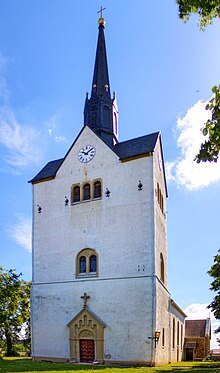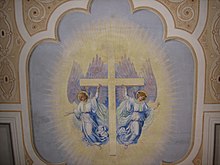Luppa Church
The Luppa Church is a church building of the Evangelical Lutheran Regional Church of Saxony in Luppa in the Saxon district of Northern Saxony . With its 54 meter high tower, the church is the landmark in the village of Luppa.
Shape and development
The sacred building is a hall church . The structure is a plastered quarry stone building with a slightly drawn-in choir and apse . The distinctive church tower has turrets and gables . There are architectural style elements from Romanesque , Gothic , Baroque , Classicism and Historicism .
The origin of the church dates back to the late 12th or early 13th century: in 1220 she became the Abbey of the Holy Cross in Meissen paid . Deutschluppa and its church were first mentioned in 1213 in a document from Margrave Dietrich the oppressed . In the Hussite church burned down in part, it was rebuilt.
Conversions took place in the years 1628, 1730 to 1734, 1835, 1872 and 1898 (tower gable). In 1985 and 1986, the exterior plaster was renewed and painted twice. The roof turret was also re-covered.
Interior design
On May 10, 1434, Auxiliary Bishop Augustine rededicated the altar, which carried statues in honor of the Virgin Mary , Saint Lawrence and Saint Agnes .
From 1730 to 1734 there were major renovations in the church: The sculptor Christian Friedrich Conrad from Calbitz made the pulpit above the altar, Achatius Carl Porsch from Wurzen created the painting.
In 1835 four new gallery carriers followed , a new man 's chair , and new chairs “for women and school boys”. The interior of the church was also renewed and the roof was repaired. The construction costs were 730 thalers, 6 groschen and 2 pfennigs.
In 1872, under Emil Albert Fraustadt , pastor in Luppa from 1854 to 1881, the church was completely renovated in its original structure; the plans for this came from the builder Hugo Altendorff . The tower received its current peak. The pulpit was moved to the south side, the sacristy was added and roof turrets were placed on the tower. In the same year the tower clock with four dials was delivered and installed by the company Zachariä from Leipzig. From 1888, a low-pressure heating system provided warmth in the church.
In 1914, the interior decoration in Art Nouveau style combined the Gothic altar with the figures acquired in 1872. In its presumed originality, the winged altar was rebuilt in 1962 during the term of office of Pastor Baetz and the Art Nouveau painting of the apse was repainted.
On the left side at the level of the gallery there is a white bust of Martin Luther .
In 1994, Pastor Leonhardi arranged for the sacristy to be repaired . The crucifixion group from 1872 was placed in the sacristy and a historic entrance door to the church was exposed.
The interior was restored between 2006 and 2008. The plaster was partially renewed. The Art Nouveau painting from 1914 has been restored. Sandstone slabs and steps were laid in the chancel. New pews modeled on the old ones were built in and a bench radiant heater was installed. A total of around € 155,000 was invested; Of this, around € 98,000 were donations, contributions and reserves of the parish.
On May 18, 2008 the church was consecrated again by Superintendent Albrecht Schmidt.
In the period from May 2007 to May 2008, parish life in Luppa was supported by the “Church-Art-Culture” project.
organ

The current organ dates from 1863, the exterior was designed in the Renaissance style. It was built by Urban Kreuzbach from Borna. Thanks to repeated restorations, including by Jehmlich Orgelbau Dresden (1977), it can still be played. According to the ORKASA organ database, it has 24 registers (10-9-5) on 2 manuals and pedal, and was last restored in 1997 by organ builder Johannes Lindner from Radebeul.
The organ has a game and register action with a mechanical slide , the pitch is 440 Hz and, according to the organ database ORKASA, the following disposition :
|
|
|
|||||||||||||||||||||||||||||||||||||||||||||||||||||||||||||||||||||||||||||||||
- Coupling : II / I, I / P
Peal
The Luppa Church has three church bells : The large bronze bell with the tone f sharp ' dates from 1437, its founder is unknown. Two bells with the tones a sharp ' and c sharp " are made of chilled iron , they come from the bell foundry Schilling and Lattermann from Apolda and Morgenröthe and were cast in 1956.
Parish
In 2008 there were almost 300 members of the Evangelical Lutheran Parish of Luppa.
The pastor's seat was in Dahlen until December 31, 2019, the parish belonged to the parish Dahlen-Großböhla with the sister parishes of Calbitz-Malkwitz and Luppa. Within the sister parishes, the pastor was responsible for five parishes.
Since January 1, 2020, the church territory reform has been in effect in the Evangelical Lutheran Church of Saxony with greater regional responsibilities.
- The pastors of the Luppa Church
- 1533: Knoth, Valentin
- 1543: Claus, Urban
- 1566: Hennig, Daniel
- 1612: Franke, Ambrosius
- 1643: Schiffmann, Bernhard
- 1662: Kademann, August d. J.
- 1669: Ritter, Matthäus
- 1677: Scheucker, Johann Heinrich
- 1791: Frenkel, Moritz Gottlob
- 1803: Neumann, Wilhelm Friedrich
- 1805: Wendler, Johann Ludwig
- 1854: Fraustadt, Emil Albert
- 1881: Lange, Emil Oskar
- 1927–1958 Fraustadt, Gottfried Georg * Johannes
- 1985: Leonhardi, Michael
- since 2009: Sehn, Andreas
Varia
- At the onset of darkness, the Luppa church , which characterizes the town, is illuminated from the outside . The Heimatverein Luppa eV collects donations for the cost of illuminating the church ; the electricity requirement is around 4 kilowatt hours (kWh) per night.
Web links
- http://www.wermsdorf.de/bildung-soziales/kirchen/evangelische-kirche-luppa.html - accessed on February 12, 2020
- https://www.kirche-an-der-dahlener-heide.de/gemeindeleben/haben-orte/luppa/ - accessed on February 12, 2020
- https://www.architektur-blicklicht.de/kirchen/luppa-kirche-wermsdorf-nordsachsen/ - accessed on February 12, 2020
- Historical interior view of the church (from 1930) - accessed February 12, 2020
literature
- Cornelius Gurlitt : Luppa. In: Descriptive representation of the older architectural and art monuments of the Kingdom of Saxony. 27. Booklet: Oschatz Official Authority (Part I) . CC Meinhold, Dresden 1905, p. 174.
- Georg Dehio : Handbook of the German art monuments, Saxony II, administrative districts Leipzig and Chemnitz. Deutscher Kunstverlag, Munich / Berlin 1998, ISBN 978-3-422-03048-0 .
Individual evidence
- ↑ https://watch-wiki.org/index.php?title=Turmuhrenfabrik_Bernhard_Zachari%C3%A4 , accessed on February 12, 2020
- ↑ https://www.bernhard-zacharia.com/default.aspx , accessed on February 12, 2020
- ↑ Jana Brechlin: Luppa church solemnly rededicated: "Your church is a miracle". In: Leipziger Volkszeitung , Oschatzer Allgemeine, Oschatz, May 20, 2008, p. 15.
- ↑ https://www.evlks.de/fiegen/kirchenmusik/orgeln/ , there under the heading ORKASA , accessed on February 16, 2020
- ^ Rainer Thümmel : Bells in Saxony - sound between heaven and earth. Evangelische Verlagsanstalt Leipzig, 2nd edition 2015, ISBN 978-3-374-02871-9 , p. 327.
- ↑ http://www.wermsdorf.de/bildung-soziales/kirchen/evangelische-kirche-luppa.html - accessed on February 12, 2020
- ↑ https://www.kirche-an-der-dahlener-heide.de/gemeindeleben/haben-orte/luppa/ - accessed on February 12, 2020
- ↑ https://www.architektur-blicklicht.de/kirchen/luppa-kirche-wermsdorf-nordsachsen/ - accessed on February 12, 2020
- ↑ https://pfarrerbuch.de/sachsen/person/-1789977372 , accessed on February 24, 2020. He is the grandson of the aforementioned pastor Albert Fraustadt
- ↑ https://pfarrerbuch.de/sachsen/stelle/1189 , accessed on February 12, 2020
- ↑ http://www.heimatverein-luppa.de/aktuelles.html , accessed on February 12, 2020
Coordinates: 51 ° 20 ′ 10.4 ″ N , 12 ° 57 ′ 30.9 ″ E




